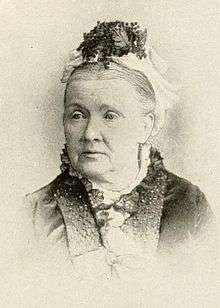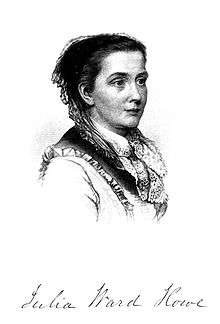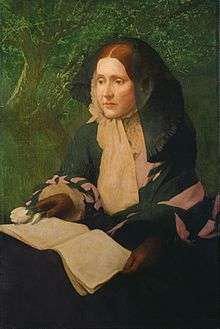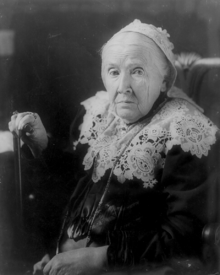Julia Ward Howe
| Julia Ward Howe | |
|---|---|
 | |
| Born |
May 27, 1819 New York City, United States |
| Died |
October 17, 1910 (aged 91) Portsmouth, Rhode Island, United States |
| Language | English |
|
| |
| Signature |
|
Julia Ward Howe (/haʊ/;[1] May 27, 1819 – October 17, 1910) was an American poet and author, best known for writing "The Battle Hymn of the Republic". She was also an advocate for abolitionism and was a social activist, particularly for women's suffrage.
Personal life
Early life
Howe was born in New York City. She was the fourth of seven children born to an upper middle class couple. Her father Samuel Ward III was a Wall Street stockbroker, well-to-do banker, and strict Calvinist. Her mother was the occasional poet Julia Rush Cutler,[2] related to Francis Marion, the "Swamp Fox" of the American Revolution. She died of tuberculosis when her daughter was five years old.
She was educated by private tutors and in schools for young ladies until she was sixteen. Her eldest brother Samuel Cutler Ward travelled in Europe and brought home a private library. She had access to these modern works, many contradicting the Calvinistic world view presented by her father.[3] She became well read and intelligent,[4][5] though as much a social butterfly as she was a scholar. She was brought into contact with some of the greatest minds of her time because of her father’s status as a successful banker. She interacted with Charles Dickens, Charles Sumner, and Margaret Fuller.[4]
Sam married into the prominent Astor family,[6] allowing him great social freedom that he shared with his sister. The siblings were cast into mourning time when their father died in 1839; shortly afterwards, brother Henry died, then Samuel's wife Emily died, along with their newborn child.
Marriage and children

Julia was visiting Boston in 1841 when she met Samuel Gridley Howe (1801—1876), a physician and reformer who founded the Perkins School for the Blind.[2][7] They announced their engagement quite suddenly on February 21. Howe had courted her for a time, but he had more recently shown an interest in her sister Louisa.[8] In 1843, they married despite their eighteen-year age difference.[2] She gave birth to their first child while honeymooning in Europe, eleven months later. She bore their last child in 1858 at the age of forty.[2] They had six children: Julia Romana Howe (1844–1886), Florence Marion Howe (1845–1922), Henry Marion Howe (1848–1922), Laura Elizabeth Howe (1850–1943), Maud Howe (1855–1948), and Samuel Gridley Howe, Jr. (1858–1863). Julia was likewise an aunt of novelist Francis Marion Crawford.
Howe lived and raised her children in South Boston, while her husband pursued his advocacy work. She hid her unhappiness with their marriage behind a cheerful demeanor and singing at parties, earning the nickname "the family champagne" from her children.[9] She made frequent visits to Gardiner, Maine where she stayed at "The Yellow House," a home built originally in 1814 and later home to her daughter Laura.[10]
Writing

She was unhappy with her surroundings, so she took lectures, and studied foreign languages, and wrote plays and dramas. Julia had published essays on Goethe, Schiller and Lamartine before her marriage to Howe, in the New York Review and Theological Review.[2]
Her book Passion-Flowers was published in December 1853. The book collected intensely personal poems and was written without the awareness of her husband, who was then editing the Free Soil newspaper The Commonwealth.[11] Her second anonymous collection, Words for the Hour, appeared in 1857.[2] She went on to write plays such as Leonora, The World’s Own, and Hippolytus. These works all contained allusions to her stultifying marriage.[2]
She went on many trips, several for missions. In 1860, she published a book, A Trip to Cuba, which told of an 1859 trip she had taken. It had generated outrage from William Lloyd Garrison, an abolitionist, for its derogatory view of Blacks. (Julia had only recently become an abolitionist in the 1850s, her family believing it to be a social evil. She thus believed it was morally right to free the slaves but did not believe in social or racial equality.)[12] Several letters on High Newport society were published in the New York Tribune in 1860, as well.[2]
Howe's being a published author troubled her husband greatly, especially due to the fact that her poems many times had to do with critiques of women’s roles as wives, her own marriage, and women’s place in society.[13][14] Their marriage problems escalated to the point where they separated in 1852. Samuel, when he became her husband, had also taken complete control of her estate income. Upon her husband’s death in 1876, she had found that through a series of bad investments that most of her money had been spent.[4]
Howe's writing and social activism were greatly shaped by her upbringing and married life. Much study has gone into her difficult marriage and how it influenced her work, both written and active.
Social activism
 |
The Battle Hymn of the Republic
"The Battle Hymn of the Republic", performed by Frank C. Stanley, Elise Stevenson, and a mixed quartet in 1908 The Battle Hymn of the Republic
"The Battle Hymn of the Republic", modern arrangement arranged by Eric Richards, performed by United States Air Force Band Airmen of Note |
| Problems playing these files? See media help. | |
She was inspired to write "The Battle Hymn of the Republic" after she and her husband visited Washington, D.C., and met Abraham Lincoln at the White House in November 1861. During the trip, her friend James Freeman Clarke suggested she write new words to the song "John Brown's Body", which she did on November 19.[15] The song was set to William Steffe's already-existing music and Howe's version was first published in the Atlantic Monthly in February 1862. It quickly became one of the most popular songs of the Union during the American Civil War.
Now that Howe was in the public eye, she produced eleven issues of the literary magazine, Northern Lights, in 1867. That same year she wrote about her travels to Europe in From the Oak to the Olive. After the war she focused her activities on the causes of pacifism and women's suffrage. By 1868, Julia’s husband no longer opposed her involvement in public life, so Julia decided to become active in reform.[2] She helped found the New England Women's Club and the New England Woman Suffrage Association. She served as president for nine years beginning in 1868.[16] In 1869, she became co-leader with Lucy Stone of the American Woman Suffrage Association. Then, in 1870, she became president of the New England Women's Club. After her husband's death in 1876, she focused more on her interests in reform. She was the founder and from 1876 to 1897 president of the Association of American Women, which advocated for women's education. She also served as president of organizations like the Massachusetts Woman Suffrage Association and the New England Suffrage Association.[17]
In 1870 she founded the weekly Woman’s Journal, a suffragist magazine which was widely read. She contributed to it for twenty years.[2] That same year, she wrote her "Appeal to womanhood throughout the world", later known as the Mother's Day Proclamation. It asked women from the world to join for world peace. (See Category:Pacifist feminism.) In 1872, she asked that "Mother's Day" be celebrated on the 2nd of June.[18][19][20][21] Her efforts were not successful, and by 1893 she was wondering if the 4th of July could be remade into "Mother's Day".[18] In 1874, she edited a coeducational defense titled Sex and Education.[16] She wrote a collection about the places she lived in 1880 called Modern Society. In 1883, Howe published a biography of Margaret Fuller. Then, in 1885 she published another collection of lectures called Is Polite Society Polite? ("Polite society" is a euphemism for the upper class.) Finally in 1899 she published her popular memoirs, Reminiscences.[2] She continued to write until her death.
In 1881, Howe was elected president of the Association for the Advancement of Women. Around the same time, Howe went on a speaking tour of the Pacific coast, and founded the Century Club of San Francisco. In 1890, she helped found the General Federation of Women’s Clubs, to reaffirm the Christian values of frugality and moderation.[2] From 1891-1893, she served as president for the second time of the Massachusetts Woman Suffrage Association. Until her death, she was president of the New England Woman Suffrage Association. From 1893 to 1898 she directed the General Federation of Women's Clubs, and headed the Massachusetts Federation of Women’s Clubs.[2] In 1908 Julia was the first woman to be elected to the American Academy of Arts and Letters, a society; its goal is to "foster, assist, and sustain excellence" in American literature, music, and art.
Death

Howe’s accomplishments mostly reside in her contribution to women’s rights.[2] She laid the foundation for women’s rights groups both in her own home and in the public eye. Howe died of pneumonia October 17, 1910, at her home, Oak Glen, in Portsmouth, Rhode Island at the age of 91.[22] She is buried in the Mount Auburn Cemetery in Cambridge, Massachusetts.[23] At her memorial service approximately 4,000 individuals sang “Battle Hymn of the Republic” as a sign of respect as it was the custom to sing that song at each of Julia’s speaking engagements.[24]
After her death, her children collaborated on a biography,[25] published in 1916. It won the Pulitzer Prize for Biography.[26]
Honors
- On January 28, 1908, at age 88, Howe became the first woman elected to the American Academy of Arts and Letters. Howe was inducted posthumously into the Songwriters Hall of Fame in 1970.
- She has been honored by the U.S. Postal Service with a 14¢ Great Americans series postage stamp issued in 1987.
- The Julia Ward Howe School of Excellence in Chicago's Austin community is named in her honor.
- The Howe neighborhood in Minneapolis, MN was named for her.[27]
- The Julia Ward Howe Academics Plus Elementary School in Philadelphia was named in her honor in 1913. It celebrates its 100th anniversary in 2013-14.
- Her Rhode Island home, Oak Glen, was added to the National Register of Historic Places in 1978.
- Her Boston home is a stop on the Boston Women's Heritage Trail.[28]
Works and collections
Poetry
- Passion-Flowers (1854)
- Words for the Hour (1857)
- From Sunset Ridge: Poems Old and New (1898)[17]
- Later Lyrics (1866)
- At Sunset (published posthumously, 1910)[17]
Other works
- The Hermaphrodite. Incomplete, but probably composed between 1846 and 1847. Published by University of Nebraska Press, 2004
- From the Oak to the Olive (travel writing, 1868)[29]
- Modern Society (essays, 1881)[17]
- Margaret Fuller (Marchesa Ossoli) (biography, 1883)[17]
- Woman's work in America (1891)
- Is Polite Society Polite? (essays, 1895)[17]
- Reminiscences: 1819–1899[30] (autobiography, 1899)[17]
See also
- List of peace activists
- List of suffragists and suffragettes
- List of women's rights activists
- Timeline of women's suffrage
- Ann Jarvis
- Gardiner, Maine, Howe's home for many years
- Samuel Gridley and Julia Ward Howe House
References
- ↑ "Julia Ward Howe". Oxford Learner's Dictionaries.
- 1 2 3 4 5 6 7 8 9 10 11 12 13 14 Sandra F. VanBurkleo Mary Jo Miles. "Howe, Julia Ward"; http://www.anb.org/articles/15/15-00348.html; American National Biography Online Feb. 2000. Access Date Nov 05 2013
- ↑ HOWE, JULIA WARD (1819-1910)."Encyclopedia of the American Civil War: A Political, Social, and Military History. Santa Barbara: ABC-CLIO, 2000. Credo Reference. Web. 07 November 2013.
- 1 2 3 "Julia Ward Howe Biography". Retrieved 21 January 2014.
- ↑ RICHARDS, LAURA (1915). Celebration of Women Writers. HOUGHTON MIFFLIN COMPANY.
- ↑ Joann, Goodman. "Julia Ward Howe".
- ↑ "Julia Ward Howe (1819-1910)". National Women's History Museum.
- ↑ Williams, Gary. Hungry Heart: The Literary Emergence of Julia Ward Howe. Amherst: University of Massachusetts Press, 1999: 33. ISBN 1-55849-157-0
- ↑ Martyris, Nina (16 March 2016). "Battle Hymn At The Dining Table: A Famous Feminist Subjugated Through Food". NPR. Retrieved 2016-07-30.
- ↑ "Gardiner Public Library, Gardiner, Maine".
- ↑ Williams, Gary. Hungry Heart: The Literary Emergence of Julia Ward Howe. Amherst: University of Massachusetts Press, 1999: 134–135. ISBN 1-55849-157-0
- ↑ "JULIA WARD HOWE (1819-1910)." Slavery in the United States: A Social, Political, and Historical Encyclopedia. Santa Barbara: ABC-CLIO, 2007. Credo Reference. Web. 14 November 2013.
- ↑ "Julia Ward Howe - National Women's Hall of Fame". National Women's Hall of Fame. Retrieved 21 January 2014.
- ↑ "Open Collections Program: Women Working, Julia Ward Howe (1819-1910)". Women Working, 1800 -- 1930. Harvard University Library. Retrieved 21 January 2014.
- ↑ Williams, Gary. Hungry Heart: The Literary Emergence of Julia Ward Howe. Amherst: University of Massachusetts Press, 1999: 208. ISBN 1-55849-157-0
- 1 2 VanBurleo, Miles
- 1 2 3 4 5 6 7 Ziegler, Valarie H. Diva Julia: The Public Romance and Private Agony of Julia Ward Howe. Harrisburg, PA: Trinity Press International, 2003: 148–149. ISBN 1-56338-418-3
- 1 2 LEIGH Eric Schmidt (1997). Princeton University Press, ed. Consumer Rites: The Buying and Selling of American Holidays (reprint, illustrated ed.). pp. 252, 348 (footnote 17 of chapter 5). ISBN 0-691-01721-2. citing Deborah Pickman Clifford, Mine Eyes Have Seen the Glory: A Biography of Julia Ward Howe (Boston: Little, Brown, 1979), 187, 207, and Julia Ward Howe, "How the Fourth of July Should Be Celebrated", Forum 15 (July 1983); 574
- ↑ The History of Mother's Day from The Legacy Project, a Legacy Center (Canada) website
- ↑ Virginia Bernhard (2002). "Mother's Day". In Joseph M. Hawes, Elizabeth F. Shores. The family in America: an encyclopedia (3, illustrated ed.). ABC-CLIO. p. 714. ISBN 1-57607-232-0.
- ↑ The First Anniversary of "Mother's Day", The New York Times, June 3, 1874, p. 8: "'Mother's Day', which was inaugurated in this city on the 2nd of June, 1872, by Mrs. Julia Ward Howards [sic], was celebrated last night at Plimpton Hall by a mother's peace meeting..."
- ↑ Ehrlich, Eugene and Gorton Carruth. The Oxford Illustrated Literary Guide to the United States. New York: Oxford University Press, 1982: 71. ISBN 0-19-503186-5
- ↑ Corbett, William. Literary New England: A History and Guide. Boston: Faber and Faber, 1993: 106. ISBN 0-571-19816-3
- ↑ HOWE, JULIA WARD (1819-1910)." Encyclopedia of the American Civil War: A Political, Social, and Military History. Santa Barbara: ABC-CLIO, 2000. Credo Reference. Web. 7 November 2013.
- ↑ Richards, Laura Elizabeth Howe; Elliott, Maud Howe; Hall, Florence Howe (1 January 1915). "Julia Ward Howe, 1819-1910". Houghton Mifflin – via Google Books.
- ↑ Ziegler, Valarie H. Diva Julia: The Public Romance and Private Agony of Julia Ward Howe. Harrisburg, PA: Trinity Press International, 2003: 11. ISBN 1-56338-418-3
- ↑ "Howe".
- ↑ "Back Bay East". Boston Women's Heritage Trail.
- ↑ Julia Ward Howe (1868). From the oak to the olive: a plain record of a pleasant journey. Lee & Shepard.
- ↑ Howe, Julia Ward (1 January 1900). "Reminiscences: 1819-1899". Houghton Mifflin Company – via Google Books.
Further reading
- Representative women of New England. Boston: New England Historical Pub. Co., 1904.
- Richards, Laura Elizabeth. Julia Ward Howe, 1819–1910. Boston: Houghton Mifflin, 1916. 2 vol.
- Clifford, Deborah Pickman. Mine Eyes Have Seen the Glory: A Biography of Julia Ward Howe. Boston: Little, Brown and Co., 1978.
- Trent, James W., Jr. The Manliest Man: Samuel G. Howe and the Contours of Nineteenth-Century American Reform. University of Massachusetts Press, 2012.
External links
| Wikiquote has quotations related to: Julia Ward Howe |
| Wikisource has original works written by or about: Julia Ward Howe |
| Wikimedia Commons has media related to Julia Ward Howe. |
Works and papers
- Works by Julia Ward Howe at Project Gutenberg
- Works by or about Julia Ward Howe at Internet Archive
- Works by Julia Ward Howe at LibriVox (public domain audiobooks)

- Howe Papers at Harvard University
- Articles by Howe Archive at "Making of America" project, Cornell University Library
- Poetry at Representative Poetry Online (University of Toronto)
- Mother's Day Proclamation (1870)
- Julia Ward Howe.org Electronic archive of Howe's life and works
- Finding Aid for the Julia Ward Howe Papers at The University of North Carolina at Greensboro
- Julia Ward Howe battle hymn from the Julia Ward Howe Papers, 1891-1898 at The University of North Carolina at Greensboro
- Free scores by Julia Ward Howe in the Choral Public Domain Library (ChoralWiki)
- The Manliest Man: Samuel G. Howe and the Contours of Nineteenth-century American Reform, by James W. Trent Jr.
- Papers,1857-1961. Schlesinger Library, Radcliffe Institute, Harvard University.
- Papers of the Julia Ward Howe family, 1787-1984. Schlesinger Library, Radcliffe Institute, Harvard University.
Biographies
- Julia Ward Howe, biography by Laura E. Richards, online at the University of Pennsylvania
- Biography Dictionary of Unitarian & Universalist Biography
- Julia Ward Howe at Answers.com
Honors
- National Women's Hall of Fame
- Ward Howe Julia Ward Howe at the Songwriters Hall of Fame
- Plaque on the Willard Hotel in Washington, D.C. marking where Howe wrote the Hymn
- Welcome to Howe Elementary School at www.mtlsd.org
Family
Other
- Julia Ward Howe at Find a Grave
- Julia Ward Howe photo from the Julia Ward Howe Papers, 1891-1898 at The University of North Carolina at Greensboro
- Carrie Chapman Catt Collection at the Library of Congress has volumes from the library of Julia Ward Howe.